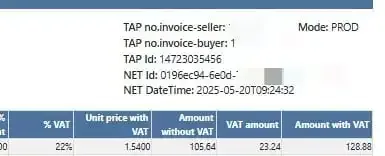All About B2B E-Invoicing in Italy
Italy’s e-invoicing framework has been mandatory for B2G since 2014, B2B for VAT-registered businesses since 2019, B2C expansion in 2024 and will move to cloud-based fiscalization by 2026


Last modified on 2025-11-07 in Countries
FatturaPA
Sistema di Interscambio (SDI)
Agenzia delle Entrate
Central Platform Exchange
2014
2019
10 years
Italy has taken a leading role in digital innovation by becoming the first EU country to require electronic invoicing for both government and private businesses. This step went beyond the original EU rules, which only applied to public sector invoicing, and even needed approval from the European Parliament. By gradually making e-invoicing mandatory for all types and sizes of businesses, Italy has built a modern digital system that helps fight tax evasion, reduces paperwork, and allows for fast and accurate data sharing. By mandating structured, secure e-invoicing and continuously refining its processes, Italy ensures high standards of business transparency and alignment with evolving EU tax regulations.
In Italy, e-invoicing is an important part of business rules and transparency. Since 2019, all VAT-registered businesses were required to send and receive electronic invoices for B2B transactions using the standard FatturaPA XML format through the government’s SdI platform. In 2022, the rules were expanded to include small businesses and all cross-border transactions.The system is regularly updated with new document types and the removal of some simplified invoice limits.
Italy is also improving its tax system by updating the e-invoicing rules. The newest changes include new document types, revised VAT codes, and the removal of the €400 limit for simplified invoices in some cases.

Tired of scrolling through information about e-invoicing?
In April 2025, Italy released version 1.9 of its e-invoicing technical specifications. Key updates include the new TD29 document type for reporting missing or irregular invoices, an updated RF20 code for EU VAT exemptions, and revised error codes to improve compliance, especially for cross-border transactions.
Ready to ensure your business meets the new 2025 requirements? Contact our experts at DDD Invoices for a free compliance consultation.

E-invoicing is the process of generating, transmitting, and storing invoices in a structured digital format. In Italy, only machine-readable e-invoices are legally valid, enabling real-time transaction tracking by tax authorities.
Reduces VAT fraud: Real-time data helps close the tax gap and combat evasion.
Boosts business efficiency: Automation means faster payments, fewer manual errors, and easier compliance checks.
Strengthens security: Digital signatures and certified archiving protect authenticity.
Aligns with EU standards: Ongoing updates keep Italy in step with European digital tax reforms.
Italy’s journey to e-invoicing leadership began with a series of legislative steps:
2007: Initial laws laying the groundwork for e-invoicing.
2014: Mandatory B2G e-invoicing for public sector suppliers, enforced by Law Decree 55/2013.
2016: Introduction of the unified FatturaPA XML schema for all invoice types.
2019: Mandatory for domestic B2B to offer e-invoices via SDI after the FatturaB2B mandate.
January 2022: B2B and B2C (with some exceptions) e-invoicing mandatory for those with an annual turnover greater than 65,000 EUR.
July 2022: Introduction of pre-filled VAT returns to speed up foreign transaction reporting.
2024: Expansion of B2C and fiscalization
2025: Version 1.9 technical specs introduce new document types and remove the €400 simplified limit.
2026: Planned shift to cloud fiscalization.
Italy’s e-invoicing relies on the government-operated Sistema di Interscambio (SdI), a centralized platform for invoice validation and exchange. These solutions help reduce errors, speed payments, and ensure invoices are stored securely for 10 years. This system supports Italy’s move toward full digital fiscalization by 2026, processing all sales and tax data online through a cloud e-invoicing infrastructure.
Want to see how Italy’s e-invoicing evolution compares with other EU countries? Explore our complete guide to e-invoicing in Europe.
In Italy, all public offices (including healthcare organizations that use the NSO platform) must handle electronic invoices through the government’s Sistema di Interscambio (SdI) platform.
To support trade between countries, the European Union introduced a rule in 2014 called Directive 2014/55/EU. This rule requires all public sector offices in EU countries to be able to receive and process electronic invoices from businesses. The goal is to make public procurement more efficient, transparent, and less costly. Each EU country had to add this rule to its national laws to ensure compliance.
Italy followed this directive by passing Decree No. 148/2018. However, Italy had already started using electronic invoicing much earlier. The first law on this was introduced in 2007 (Law No. 244/2007, Article 1, paragraphs 209 to 213).
Italy made e-invoicing mandatory for government suppliers and later expanded it to B2B and B2C transactions as well. Because of these early steps, Italy is considered one of the leading countries in digital invoicing and tax digitalization in Europe.
Mandatory Use of SdI: All invoices issued to public administrations must be transmitted electronically via SdI, ensuring centralized validation, processing, and delivery.
Invoice Format: Invoices must comply with the FatturaPA XML format, which includes specific fields required by public procurement regulations.
Additional Mandatory Data: B2G invoices must include unique identifiers such as the Codice Univoco Ufficio (CUU) for the public entity, and if applicable, the CIG (Tender Identification Code) and CUP (Project Code) related to the procurement.
Digital Signature and Timestamp: To guarantee authenticity and integrity, invoices must be digitally signed
Invoice Rejection: Invoices missing any mandatory information or not complying with the format are rejected by SdI and will not be paid.
Italy’s B2B e-invoicing regime is a pillar of its digital tax transformation. If you are a VAT-registered business in Italy, you are required by law to issue electronic invoices for all domestic B2B transactions. This means every invoice you send to another business must be in the standardized XML format and submitted through the government’s Sistema di Interscambio (SdI) platform.
In the European Union, electronic invoicing between private companies (B2B) is generally governed by Directive 2010/45/EU, which amends the common system of value-added tax under Directive 2006/112/EC. This directive aims to improve the functioning of the internal market and promote interoperability among member states.
A key provision of Directive 2010/45/EU is that the use of electronic invoicing in B2B transactions is subject to the acceptance of the invoice recipient. This means that, under normal EU rules, a business cannot be forced to accept electronic invoices unless it agrees to do so.
However, Italy sought and obtained a specific exemption from this rule. Through Implementing Decision (EU) 2018/593, the European Commission authorized Italy to make electronic invoicing mandatory for B2B transactions without requiring recipient acceptance. This exception became effective in 2018 and allowed Italy to implement its nationwide mandatory B2B e-invoicing system starting January 1, 2019.

As of January 1, 2024, electronic invoicing is mandatory for nearly all B2C transactions in Italy, with only limited sectoral exemptions remaining (e.g., healthcare). This follows Italy’s pioneering move in 2019 to require e-invoicing for both B2B and B2C transactions.
Fiscalization in B2C retail transactions, often referred to as "Scontrino," is a system designed to ensure that every sale is accurately recorded and reported to tax authorities. This process helps prevent tax evasion by making sales traceable and compliant with fiscal regulations.
How Fiscalization Works in B2C Retail Transactions:
Sales data is immediately reported to tax authorities via SdI or certified fiscal devices.
Consumers can access transaction records through their tax accounts for transparency.
Italy is transitioning to cloud-based fiscalization solutions to automate compliance and reduce errors.
Some sectors, notably healthcare, remain exempt from fiscalization to protect privacy.
POS providers can simplify compliance with an easy-to-integrate API solution.
Consumer Protection: Fiscalization ensures consumers receive authentic, government-validated invoices.
Market Fairness: Reduces tax evasion in retail, creating a level playing field.
Digital Transformation: Supports Italy’s broader digitalization goals and aligns with EU best practices.
.webp&w=1920&q=75)
Foreign electronic invoices involving Italian businesses must be sent through Italy's SdI platform within specific deadlines to comply with VAT rules. Since July 2022, the Italian Tax Authority has required that all cross-border invoices, whether they are issued to or received from Italian VAT-registered companies, be reported electronically through the SdI system using the FatturaPA XML format. This requirement applies to both incoming and outgoing international invoices.
If a foreign invoice is not sent through the SdI system on time, usually by the 15th day of the month after the transaction date, it will be rejected with error code 00477. This rule shows how serious Italy is about VAT compliance and transparency in international trade.
Foreign companies that do not have an Italian VAT number do not have to send e-invoices through SdI. However, the Italian customer must create a "self-invoice" in the FatturaPA format and send it through SdI to make sure the transaction is properly recorded for tax purposes.
On the other hand, foreign companies that are registered in Italy or have an Italian VAT number must issue their invoices in the FatturaPA format and send them through SdI.
The Italian invoicing system is known as the Sistema di Interscambio (SdI) and is managed by the Agenzia delle Entrate, the tax authority of Italy.
Similar e-invoicing platforms are also used in countries like Serbia and Poland.
How SDI Works:
SDI checks each invoice for legal and technical compliance before forwarding it to the recipient and reporting it to the tax authorities.
To send an invoice, you must include a recipient identifier: a Codice Destinatario (unique code), a PEC email address, or the default code “0000000” if neither is available.
If an invoice is missing information or contains errors, SDI rejects it and sends an error message. The business must correct and resend the invoice. Non-compliance can result in penalties, including fines up to 180% of the VAT amount.
SDI does not store invoices. By law, businesses must archive invoices securely in digital format for ten years.
For businesses seeking to automate and integrate these processes directly into their accounting or ERP software, our software-based e-invoicing and fiscalization APIs offer a seamless solution for compliance and efficiency.
Unlike many EU countries, Italy has not implemented the SAF-T (Standard Audit File for Tax) format. Instead, it relies on the SdI platform for real-time invoice data submission and monitoring.
The older LIPE (Liquidazioni Periodiche IVA) periodic VAT return, which required monthly VAT transaction reporting, has been largely replaced by the real-time e-invoicing via SdI for domestic transactions. However, some residual VAT reporting obligations remain for specific cases, but SdI data largely fulfills VAT control needs.
To navigate Italy’s e-invoicing landscape, here's what to consider when choosing a provider:
Data Conversion: The provider should be capable of converting internal invoice data (JSON) into the FatturaPA XML format, which is required for submission to the Sistema di Interscambio (SdI).
Multi-Country Compliance: Opt for a provider that supports various compliance requirements and formats, which is especially important for businesses involved in international trade within the European e-invoicing ecosystem.
Integration and Compatibility: Prioritize providers offering flexible APIs and pre-built connectors to ensure fast integration and compatibility with existing ERP and accounting systems.
Transaction Type Support: The e-invoicing provider should handle all transaction types, including B2B, B2C, and B2G, while addressing the specific regulatory nuances of each category.
Security and Compliance: Ensure the provider offers encrypted data transmission, GDPR adherence, and long-term archiving that complies with Italy’s 10-year retention rule.
Automation: Look for solutions that automate the e-invoicing process, from JSON-to-XML conversion and SdI submission to digital archiving. Automation can reduce manual effort and errors and help businesses stay compliant with regulatory updates.
Handling e-invoicing in Italy can feel complicated, but you don’t have to do it on your own. With rules and technical requirements constantly changing, working with a certified provider is the best way to protect your business and keep everything running smoothly.
DDD Invoices makes it easy. We connect with SDI, send your invoices automatically, and store them safely in a way that meets all legal requirements. This means you can spend less time on paperwork and more time focusing on your business.
Our platform helps reduce mistakes, saves time, and makes sure every invoice follows the latest rules in Italy and the EU. You won’t have to worry about errors or missing deadlines.
Let DDD Invoices take care of the complex parts of e-invoicing, so you can enjoy the full benefits of going digital.
Still have questions?
In the 30min free call we will discuss:
All VAT-registered businesses in Italy must use electronic invoicing for B2B, B2C (with some exceptions), and B2G transactions. This includes sending and receiving invoices through the government’s Sistema di Interscambio (SdI) platform using the FatturaPA XML format. Since 2022, most small businesses and cross-border transactions are also included.
If an invoice is missing information or contains errors, the SdI platform will reject it and send you an error notification. You must correct the issues and resubmit the invoice. Failure to comply can result in penalties, including fines up to 180% of the VAT amount involved.
A digital signature is mandatory for invoices sent to public administrations (B2G). For B2B and B2C invoices, while not always strictly required, a digital signature is strongly recommended to ensure authenticity, integrity, and legal compliance.
Written by the Compliance team
Reviewed by Denis V. P.